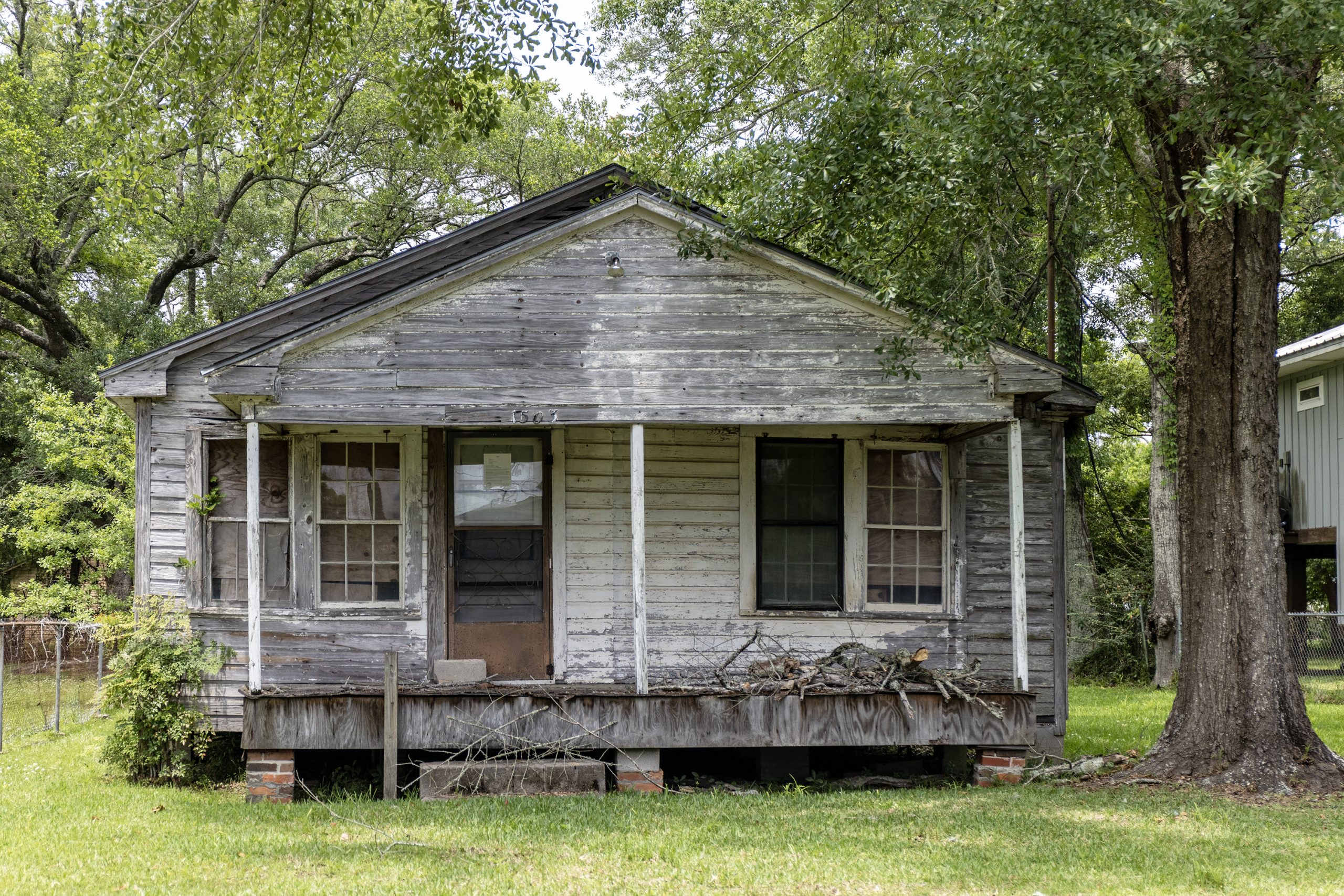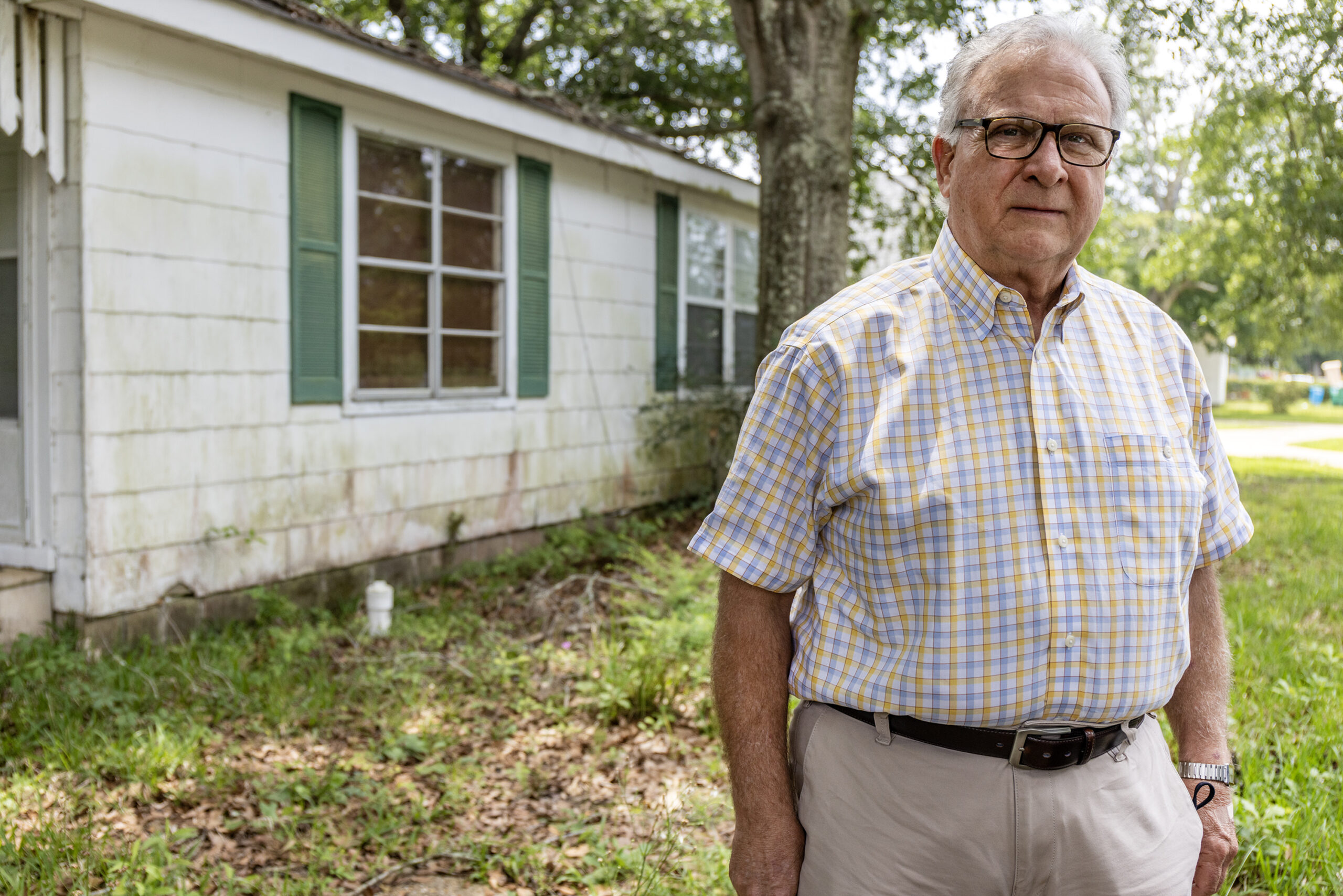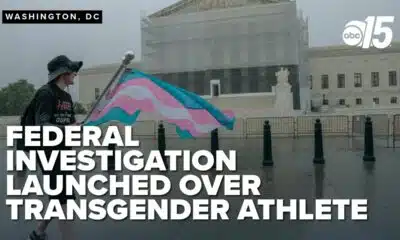Mississippi Today
Katrina-era regulations dash hopes of reclaiming Pascagoula homes

PASCAGOULA — Massive tree branches stretch overhead, shading the small brick house decades past its prime.
Rundown with a rotting carport, it shows every bit of the some 100 years it’s spent on its patch of Midway Avenue. An aged board blocks off the front door. Shutters are missing; windows busted. The inside is an 897-square-foot shell.
The walls are solid brick; the house sits on a concrete slab. Through the overgrown weeds and algae-seeped walls of the screened-in porch, Rony Hernandez saw his family’s dream home. He grew up doing construction with his father. He was confident he could handle the renovation.
But those dreams came to a halt during Hernandez’s first trip to the city for building permits. The Ingalls Shipbuilding employee wanted to live where he worked — but fixing up the old home is going to take more than sweat equity.
It might take a miracle.

Not because of the home itself, but because of the Hurricane Katrina-era regulations that residents say hang over Pascagoula like a dark cloud. In order for a municipality to take part in the National Flood Insurance Program (NFIP), it has to agree to adopt certain building codes for flood zones recommended by the Federal Emergency Management Agency. That’s where the “50% rule” comes into play.
Hernandez’s fixer-upper is valued at just $36,000 and sits about 2 feet below the Pascagoula’s base flood level. Under the current building code, the city can only permit Hernandez half the home’s value in repairs over a 10-year period.
That leaves just $18,000 for a complete makeover, labor costs included. More than 90% of the city is in a flood zone, beholden to the same set of rules. Before the flood maps were redone in 2009, only about 15% of the city was in designated flood zones.
“We are in a situation with the city that we cannot issue permits for those people needing and wanting to do improvements over 50%,” said Pascagoula Mayor Jay Willis. “So, in many cases, we are condemning these properties, and they are in the process of being demolished when, if this rule didn’t exist, they could very well be brought back into code.”
Nearby cities on the Gulf Coast have had an explosive housing market with skyrocketing property values and a surge in new builds. Even as investments in Pascagoula’s downtown mean new apartments, and a $6.8 million hotel, much of the city’s residential neighborhoods are lagging well behind the surrounding cities.
FEMA officials explained that the NFIP rules about making improvements, which Congress enacted decades ago, are meant to deter over-investing in properties that are vulnerable to flooding.
“We, as public servants – FEMA, the state and local officials, owe it to the residents and businesses to work together to take actions that will help keep us safer,” FEMA spokesperson Crystal Paulk-Buchanan said in a written response to Mississippi Today. “When communities adopt and enforce floodplain management regulations that include strong building codes, disaster impacts are less severe, and recovery is faster.”
But to those in Pascagoula, it feels like they got slammed twice. First from Katrina, and then with building permit regulations that have crippled the city from making a meaningful comeback over the last decade.
“We’ve got more going on in construction and development in this town than we’ve had in 30 years,” said Josh Church, the city’s planning and building director. “But it has been a battle from day one.”
The only way Pascagoula’s homeowners in the city’s flood zones can spend more than 50% of a home’s value on renovations is if they elevate the structure above the base flood level. But many older homes are attached to concrete slabs, making them much more expensive to raise.
Raising an existing house is costly, as is building a new house higher up.
As a result, Pascagoula neighborhoods sit as a stark divide between the have and have-nots: New luxury homes high on stilts and old homes falling deeper and deeper into disrepair until the city has no choice but to declare them condemned.
And more and more, the working class — people like Hernandez — say they’re being squeezed out of affording a safe place to live that can help build wealth for their families. Hernandez saved up to redo an old home, but he doesn’t have the income to build a new one from scratch.
The abandoned homes and overgrown lots that litter Pascagoula are a constant reminder of how much Katrina changed the trajectory of a city known for its major economic contributions to the state. It is home to Chevron, an oil refinery, and Ingalls Shipbuilding, which employs more than 11,000 people.

Every weekday the city’s population of 20,000 doubles to 40,000 when workers commute in, but shrinks back down once they clock out, according to estimates from the mayor’s office.
Hernandez, 32, wants to live in Pascagoula, but he and most of his coworkers are spread out across nearby cities such as Moss Point and Ocean Springs or out of state in Alabama — their paychecks, made in Pascagoula, rarely circulate much in the city’s economy. They can’t find homes available in Pascagoula: they’re typically run down or elevated seaside mansions.
“I feel like part of the community already and, as part of the community, I see what’s going on, I see how these types of regulations hurt the community,” Hernandez said in front of the old house on Midway. “Because, look, we got a vacant house over here. Hopefully, hopefully, I will be able to fix it. But a lot of people they’re not even trying. They buy properties, they can’t fix them. And then they become trash.”
On the first Tuesday of every month, Church, the building director, gives a short presentation before Pascagoula’s city council, pinpointing nuisance properties.
He and his team of code enforcement agents have a list of about 150 properties they’ve flagged as derelict or dangerous. Property by property, they work through the list by calling the owners, sending warning letters and posting notices. Going before the city or to court is the last-ditch effort to clean up the city.
Property owners have a chance to speak at a public hearing before the board votes on whether the property should be torn down.
Most don’t show. The ones who do are regularly facing an unfortunate reality: Their properties are too far gone to fix, especially with the 50% rule looming overhead.
The problem properties range from overgrown vacant lots where houses were long ago torn down to abandoned retail spots to dozens of dilapidated houses that have been empty for years, many since 2005, when Katrina flooded the city.
“If they don’t live here 75 to 80% of them don’t care,” Church said. “You can send them letters all you want. It’s just like talking to that wall. They don’t see it, they don’t care about it.”
The nuisance property problem isn’t a coast-wide problem. It’s a Pascagoula problem that most agree traces back to Katrina’s damages, the regulations that followed, and increasing flood insurance costs that make it more and more difficult to justify investing in existing structures.
Some of the properties were passed down to relatives after a death. Many wind up in the hands of out-of-state owners who wanted to turn a quick buck after winning a tax lien certificate in an auction with the city but don’t bother investing in the parcel or old home’s upkeep.
Once the nuisance properties are gone, city leaders hope it will attract more new builds.

“We have people coming in that are recognizing the great things that are happening in Pascagoula and wanting to be part of it,” said Willis, the Pascagoula mayor. “The next step of that is to get into the residential housing area, and have some of these investors building houses here, and hopefully that’s where we’re going.”
In the interim, there is some risk: Once a house — even a derelict house — is gone, the property taxes may go from $1,000 a year down to $30. It’s an immediate impact on the city’s tax base.
Meanwhile, builders and investors are struggling to turn the profits needed to justify Pascagoula builds in residential neighborhoods.
Brandi and Brandon Busby scurried around a brand-new three bedroom home they built from the ground up in Pascagoula, checking items off their “to do’s” before handing the keys over to the house’s new owner.
The Busbys just built Pascagoula’s first new housing development since 2001. Six homes total.
“We had planned to build 11,” Brandi said, leaning over the kitchen’s glossy marble counters. “But we had to stop. The problem with construction in Pascagoula versus, say, Ocean Springs, is we are paying $26,000 more here to raise the house up, and it eats our profit margin.”
The Busbys bought a parcel of land on Mantou Street that once held three dilapidated homes the couple described as shacks. The land was slightly higher than in much of the rest of the city, so while the homes needed to be raised some to meet the regulations of new construction, they’re not towering over the neighborhood.
The homes are elevated on brick foundation, with stairs leading to a porch. They have sleek siding in neutral colors. The ceilings are high and the kitchen and living areas are bright and open.
With the cost of building materials, the Busbys said it’s impossible to build a new home for under $200,000 and turn a profit. Add in the extra costs of elevating in Pascagoula and high homeowners’ and flood insurance rates, it’s easy to quickly be priced out.
“There’s no in between anymore,” Brandi said, referring to Pascagoula’s makeup. “It’s either 800-square-foot little Navy houses (built during World War II) or a mansion on Washington Avenue.”
The Busbys have a history of turning down Pascagoula remodel requests. In the city’s flood zones, new construction needs to be elevated — even if it’s a room addition on a lower-lying home.
They wanted to improve Pascagoula but had to stop short of their goal. The costs just didn’t make sense. Pascagoula houses already sit on the market longer than in competing coast cities. Not only are they more expensive to build, but also the flood zones in the county’s lowest lying areas make them less valuable to sell. One misstep could mean losing money on a build.
“At the end of the day, we’re a business,” Brandi said, “and we have to keep food on our own table.”
Brandon, Brandi’s husband, worries about Pascaogula’s long-term future — beyond just the 50% rule that keeps him from even attempting to flip the city’s older homes.

Homeowner insurance is skyrocketing along the state’s coastal cities, with one insurance agent seeing increases of 15-70%. Inflation and the overall risk of natural disasters are all contributing to the growing costs. Flood insurance prices are getting steeper on much of the coast, too.
In 2021, FEMA began using new metrics to determine the costs of the National Flood Insurance Program by assessing a property’s risk, especially its proximity to water.
At first, the rule change only affected new policies. Existing policies didn’t increase until the following year. While some folks may be grandfathered in to lower rates, they will increase each year — usually at 18%.
“The $1,800 you’re paying now won’t stay $1,800,” Brandon said. “People don’t seem to understand the magnitude of that. In three to four years, Pascagoula is going to be a ghost town for that reason.”
Realtor Lazaro Rovira primarily sells homes to Hispanic families who work at Ingalls and Chevron.
“They want to live in Pascagoula,” he said. “It’s convenient because you already have the Hispanic population here, the Hispanic supermarkets and the restaurants.”
But he sees how many of them are opting out of the headache of homeownership in Pascagoula because there’s a shortage of reasonable homes. He also sees potential homeowners running the numbers and opting for properties they think may be a better, long-term investment.
He recalls one recent Pascagoula home he sold for $135,000.
“When you add the flood insurance and everything, her payments were $1,400 a month, which is a lot of money,” he said. “If you’re going to pay that much, you might as well go to newer construction in Ocean Springs. It just makes more sense for a lot of people.”
Rovira applauds the mayor’s office for attacking the nuisance property problem and for standing up against the 50% rule. But he’s worried about what could actually be done.
“We’ve been complaining about this for a long time,” he said of those in real estate. “And this is literally the first administration to actually notice and take action to do something about it … Even for them just to try, really speaks volumes.”
If the 50% rule were to be lifted, or changed, Rovira said “it’s going to open up the floodgates to Pascagoula” renovations.
Like Rovira, resident Bernie O’Sullivan has a soft spot for Pascagoula’s historic properties at risk of being torn down.
She and her husband bought a large Victorian built in the late 1800s for $85,000 in 2017 with plans to flip it. But it wound up costing $50,000 just to raise it 3-and-a-half feet to make the home no longer subject to the 50% rule.
“If we would have done the renovations under the 50% rule, in the next 10 years we couldn’t do anything to fix the house if anything happened,” she said. “A little kitchen fire, anything … (the city) would have shut us down when we asked for more permits.”
She said friends and city workers were skeptical if she could pull off the project. Once the home was finished, she couldn’t let it go. She and her husband moved in.
She knows what she did is the exception. Most people don’t have the means to save an old house the way she did.
“And that’s why so many people in Pascagoula just walk away from their properties,” she said.
Asked about criticism of the 50% rule from Coast locals, FEMA called the policy a compromise: the rule allows investment in flood zones while taking into account the risk of repeated damages.
Officials told to Mississippi Today that they’re working with local and state officials to address concerns.
But Clayton French, the deputy director of the Mississippi Emergency Management Agency, said he understood where Pascagoula homeowners were coming from, saying that those looking to make improvements are “trapped.”
“I think the real answer is Congress needs to relook this again,” French said, explaining what it would take to change the policy. “They probably made some choices, just guessing, years ago, and now they’re seeing the fruits of some of those choices.
Pascagoula is low lying. The Gulf waters near Pascagoula are shallow. That means there’s not a lot of room for it to absorb storm surge. Unlike New Orleans, there isn’t a levy built to control it.
Most Pascagoula locals view Katrina as a 100-year storm. They’re not worried about it happening again.
According to NFIP data, the program saw an average of 51 flood insurance claims from Pascagoula between 1977 and 2004, the year before Katrina. Since Katrina, that number’s dropped to 33 per year.
“When you look at the number of flood claims, it’s not the issue,” said Pascagoula resident Jimmy Fondren, a Republican candidate for the Mississippi House. “The issue is the mapping … People shouldn’t be told by the federal government what they can and can’t do with their own homes.”
Pascagoula leadership is figuring out what next steps could help the city.
It could opt out of FEMA’s flood insurance program altogether to avoid the building requirements it has to impose to be in the program.
Mayor Willis said the city would have to carefully consider making such a move and would only do it if a private insurer was able to step up and back the city in FEMA’s place.
Willis and other local leaders say they’ve spoken to Congress members about altering the FEMA requirements so Pascagoula wouldn’t have to adopt a 50% rule — but maybe a 100% percent rule — that would allow homeowners in the city to at least make improvements up to the full value of what the house is worth.
Republican 4th District U.S. Rep. Mike Ezell said he has “made it a priority to work with other members, especially our neighbors from other Gulf Coast districts, to address these problems and provide much-needed relief to our coastal communities.”
“As a Pascagoula native and a lifelong resident of the Gulf Coast, I’ve witnessed the negative impacts of the 50% rule on Pascagoula, especially on young families who can’t afford to live in my hometown. I’ve also seen how cities and towns across the Gulf Coast struggle because of delays in reimbursements and other FEMA programs.”
If a 100% rule went into effect, Hernandez would have enough room to fix his home and have enough wiggle room should he need to add in other repairs over the next 10 years. Before he knew about the 50% rule, he planned to spend about $20,000 in home improvements.
For now, he’s stuck. He’s struggling to find a contractor willing to come give the estimate he needs to give to the city before the planning office can even consider issuing a building permit.
The longer the house sits, the more likely it could one day end up on the city’s list of homes it has no choice but to condemn and knock down.
Hernandez saw a future in the one-story home. He got it for a low price, but has already spent several thousands of dollars renting dumpsters just to clear our trash from the house’s yard.
He grew up in New Orleans. He understands the risk of living in a low-lying area.
He purchased the house in 2017 with high hopes. It was supposed to become the perfect home for his three kids and his two sisters he’s helping raise.
“We bought it thinking that we were gonna be able to move here,” Hernandez said, looking at the little brick house.
He just wants that to be true.
Mississippi Today Reporter Alex Rozier contributed to this report.
This article first appeared on Mississippi Today and is republished here under a Creative Commons license.
Did you miss our previous article…
https://www.biloxinewsevents.com/?p=247383
Mississippi Today
Trump nominates Baxter Kruger, Scott Leary for Mississippi U.S. attorney posts
President Donald Trump on Tuesday nominated Baxter Kruger to become Mississippi’s new U.S. attorney in the Southern District and Scott Leary to become U.S. attorney for the Northern District.
The two nominations will head to the U.S. Senate for consideration. If confirmed, the two will oversee federal criminal prosecutions and investigations in the state.
Kruger graduated from the Mississippi College School of Law in 2015 and was previously an assistant U.S. attorney for the Southern District. He is currently the director of the Mississippi Office of Homeland Security.
Sean Tindell, the Mississippi Department of Public Safety commissioner, oversees the state’s Homeland Security Office. He congratulated Kruger on social media and praised his leadership at the agency.
“Thank you for your outstanding leadership at the Mississippi Office of Homeland Security and for your dedicated service to our state,” Tindell wrote. “Your hard work and commitment have not gone unnoticed and this nomination is a testament to that!”
Leary graduated from the University of Mississippi School of Law, and he has been a federal prosecutor for most of his career.
He worked for the U.S. Attorney’s Office in the Western District of Tennessee in Memphis from 2002 to 2008. Afterward, he worked at the U.S. Attorney’s Office for the Northern District of Mississippi in Oxford, where he is currently employed.
Leary told Mississippi Today that he is honored to be nominated for the position, and he looks forward to the Senate confirmation process.
This article first appeared on Mississippi Today and is republished here under a Creative Commons Attribution-NoDerivatives 4.0 International License.
The post Trump nominates Baxter Kruger, Scott Leary for Mississippi U.S. attorney posts appeared first on mississippitoday.org
Note: The following A.I. based commentary is not part of the original article, reproduced above, but is offered in the hopes that it will promote greater media literacy and critical thinking, by making any potential bias more visible to the reader –Staff Editor.
Political Bias Rating: Centrist
This article presents a straightforward news report on President Donald Trump’s nominations of Baxter Kruger and Scott Leary for U.S. attorney positions in Mississippi. It focuses on factual details about their backgrounds, qualifications, and official responses without employing loaded language or framing that favors a particular ideological perspective. The tone is neutral, with quotes and descriptions that serve to inform rather than persuade. While it reports on a political appointment by a Republican president, the coverage remains balanced and refrains from editorializing, thus adhering to neutral, factual reporting.
Mississippi Today
Jackson’s performing arts venue Thalia Mara Hall is now open
After more than 10 months closed due to mold, asbestos and issues with the air conditioning system, Thalia Mara Hall has officially reopened.
Outgoing Mayor Chokwe A. Lumumba announced the reopening of Thalia Mara Hall during his final press conference held Monday on the arts venue’s steps.
“Today marks what we view as a full circle moment, rejoicing in the iconic space where community has come together for decades in the city of Jackson,” Lumumba said. “Thalia Mara has always been more than a venue. It has been a gathering place for people in the city of Jackson. From its first class ballet performances to gospel concerts, Thalia Mara Hall has been the backdrop for our city’s rich cultural history.”
Thalia Mara Hall closed last August after mold was found in parts of the building. The issues compounded from there, with malfunctioning HVAC systems and asbestos remediation. On June 6, the Mississippi State Fire Marshal’s Office announced that Thalia Mara Hall had finally passed inspection.
“We’re not only excited to have overcome many of the challenges that led to it being shuttered for a period of time,” Lumumba said. “We are hopeful for the future of this auditorium, that it may be able to provide a more up-to-date experience for residents, inviting shows that people are able to see across the world, bringing them here to Jackson. So this is an investment in the future.”
In total, Emad Al-Turk, a city contracted engineer and owner of Al-Turk Planning, estimates that $5 million in city and state funds went into bringing Thalia Mara Hall up to code.
The venue still has work to be completed, including reinstalling the fire curtain. The beam in which the fire curtain will be anchored has asbestos in it, so it will have to be remediated. In addition, a second air-conditioning chiller needs to be installed to properly cool the building. Until it’s installed, which could take months, Thalia Mara Hall will be operating at a lower seating capacity of about 800.
“Primarily because of the heat,” Al-Turk said. “The air conditioning would not be sufficient to actually accommodate the 2,000 people at full capacity, but starting in the fall, that should not be a problem.”
Al-Turk said the calendar is open for the city to begin booking events, though none have been scheduled for July.
“We’re very proud,” he said. “This took a little bit longer than what we anticipated, but we had probably seven or eight different contractors we had to coordinate with and all of them did a superb job to get us where we are today.”
This article first appeared on Mississippi Today and is republished here under a Creative Commons Attribution-NoDerivatives 4.0 International License.
The post Jackson’s performing arts venue Thalia Mara Hall is now open appeared first on mississippitoday.org
Note: The following A.I. based commentary is not part of the original article, reproduced above, but is offered in the hopes that it will promote greater media literacy and critical thinking, by making any potential bias more visible to the reader –Staff Editor.
Political Bias Rating: Centrist
The article presents a straightforward report on the reopening of Thalia Mara Hall in Jackson, focusing on facts and statements from city officials without promoting any ideological viewpoint. The tone is neutral and positive, emphasizing the community and cultural significance of the venue while detailing the challenges overcome during renovations. The coverage centers on public investment and future prospects, without partisan framing or editorializing. While quotes from Mayor Lumumba and a city engineer highlight optimism and civic pride, the article maintains balanced, factual reporting rather than advancing a political agenda.
Mississippi Today
‘Hurdles waiting in the shadows’: Lumumba reflects on challenges and triumphs on final day as Jackson mayor
On his last day as mayor of Jackson, Chokwe Antar Lumumba recounted accomplishments, praised his executive team and said he has no plans to seek office again.
He spoke during a press conference outside of the city’s Thalia Mara Hall, which was recently cleared for reopening after nearly a year of remediation. The briefing, meant to give media members a peek inside the downtown theater, marked one of Lumumba’s final forays as mayor.
Longtime state Sen. John Horhn — who defeated Lumumba in the Democratic primary runoff — will be inaugurated as mayor Tuesday, but Lumumba won’t be present. Not for any contentious reason, the 42-year-old mayor noted, but because he returns to his private law practice Tuesday.
“I’ve got to work now, y’all,” Lumumba said. “I’ve got a job.”
Thalia Mara Hall’s presumptive comeback was a fitting end for Lumumba, who pledged to make Jackson the most radical city in America but instead spent much of his eight years in office parrying one emergency after another. The auditorium was built in 1968 and closed nearly 11 months ago after workers found mold caused by a faulty HVAC system – on top of broken elevators, fire safety concerns and vandalism.
“This job is a fast-pitched sport,” Lumumba said. “There’s an abundance of challenges that have to be addressed, and it seems like the moment that you’ve gotten over one hurdle, there’s another one that is waiting in the shadows.”
Outside the theater Monday, Lumumba reflected on the high points of his leadership instead of the many crises — some seemingly self-inflicted — he faced as mayor.
He presided over the city during the coronavirus pandemic and the rise in crime it brought, but also the one-two punch of the 2021 and 2022 water crises, exacerbated by the city’s mismanagement of its water plants, and the 18-day pause in trash pickup spurred by Lumumba’s contentious negotiations with the city council in 2023.
Then in 2024, Lumumba was indicted alongside other city and county officials in a sweeping federal corruption probe targeting the proposed development of a hotel across from the city’s convention center, a project that has remained stalled in a 20-year saga of failed bids and political consternation.
Slated for trial next year, Lumumba has repeatedly maintained his innocence.
The city’s youngest mayor also brought some victories to Jackson, particularly in his first year in office. In 2017, he ended a furlough of city employees and worked with then-Gov. Phil Bryant to avoid a state takeover of Jackson Public Schools. In 2019, the city successfully sued German engineering firm Siemens and its local contractors for $89 million over botched work installing the city’s water-sewer billing infrastructure.
“I think that that was a pivotal moment to say that this city is going to hold people responsible for the work that they do,” Lumumba said.
Lumumba had more time than any other mayor to usher in the 1% sales tax, which residents approved in 2014 to fund infrastructure improvements.
“We paved 144 streets,” he said. “There are residents that still are waiting on their roads to be repaved. And you don’t really feel it until it’s your street that gets repaved, but that is a significant undertaking.”
And under his administration, crime has fallen dramatically recently, with homicides cut by a third and shootings cut in half in the last year.
Lumumba was first elected in 2017 after defeating Tony Yarber, a business-friendly mayor who faced his own scandals as mayor. A criminal justice attorney, Lumumba said he never planned to seek office until the stunning death of his father, Chokwe Lumumba Sr., eight months into his first term as mayor in 2014.
“I can say without reservation, and unequivocally, we remember where we started. We are in a much better position than we started,” Lumumba said.
Lumumba said he has sat down with Horhn in recent months, answered questions “as extensively as I could,” and promised to remain reachable to the new mayor.
This article first appeared on Mississippi Today and is republished here under a Creative Commons Attribution-NoDerivatives 4.0 International License.
The post 'Hurdles waiting in the shadows': Lumumba reflects on challenges and triumphs on final day as Jackson mayor appeared first on mississippitoday.org
Note: The following A.I. based commentary is not part of the original article, reproduced above, but is offered in the hopes that it will promote greater media literacy and critical thinking, by making any potential bias more visible to the reader –Staff Editor.
Political Bias Rating: Center-Left
The article reports on outgoing Jackson Mayor Chokwe Antar Lumumba’s reflections without overt editorializing but subtly frames his tenure within progressive contexts, emphasizing his self-described goal to make Jackson “the most radical city in America.” The piece highlights his accomplishments alongside challenges, including public crises and a federal indictment, maintaining a factual tone yet noting contentious moments like labor disputes and governance issues. While it avoids partisan rhetoric, the focus on social justice efforts, infrastructure investment, and crime reduction, as well as positive framing of Lumumba’s achievements, aligns with a center-left perspective that values progressive governance and accountability.
-
News from the South - Georgia News Feed6 days ago
Are you addicted to ‘fridge cigarettes’? Here’s what the Gen Z term means
-
News from the South - Oklahoma News Feed7 days ago
RFK Jr. Brings MAHA to Oklahoma
-
News from the South - South Carolina News Feed6 days ago
Federal investigation launched into Minnesota after transgender athlete leads team to championship
-
The Center Square5 days ago
U.S. Senate prepares for passage of One Big Beautiful Bill Act | National
-
News from the South - Tennessee News Feed5 days ago
Democratic resolution to block military action in Iran fails to advance in US Senate
-
News from the South - Virginia News Feed7 days ago
‘Hallowed ground, desecrated’: ICE sweeps at Chesterfield court draw fierce backlash
-
News from the South - Louisiana News Feed5 days ago
Water company hiked sewage rates in Lafayette to state’s highest
-
News from the South - Florida News Feed7 days ago
US Supreme Court allows SC to remove Planned Parenthood from list of Medicaid providers

















































